How to Make Sourdough Starter
All great sourdough bread recipes begin with a sourdough starter recipe and this easy starter is no nonsense! Making your own sourdough starter is so simple and it’s almost impossible to ruin. Keep it in the fridge to use in so many classic sourdough recipes.
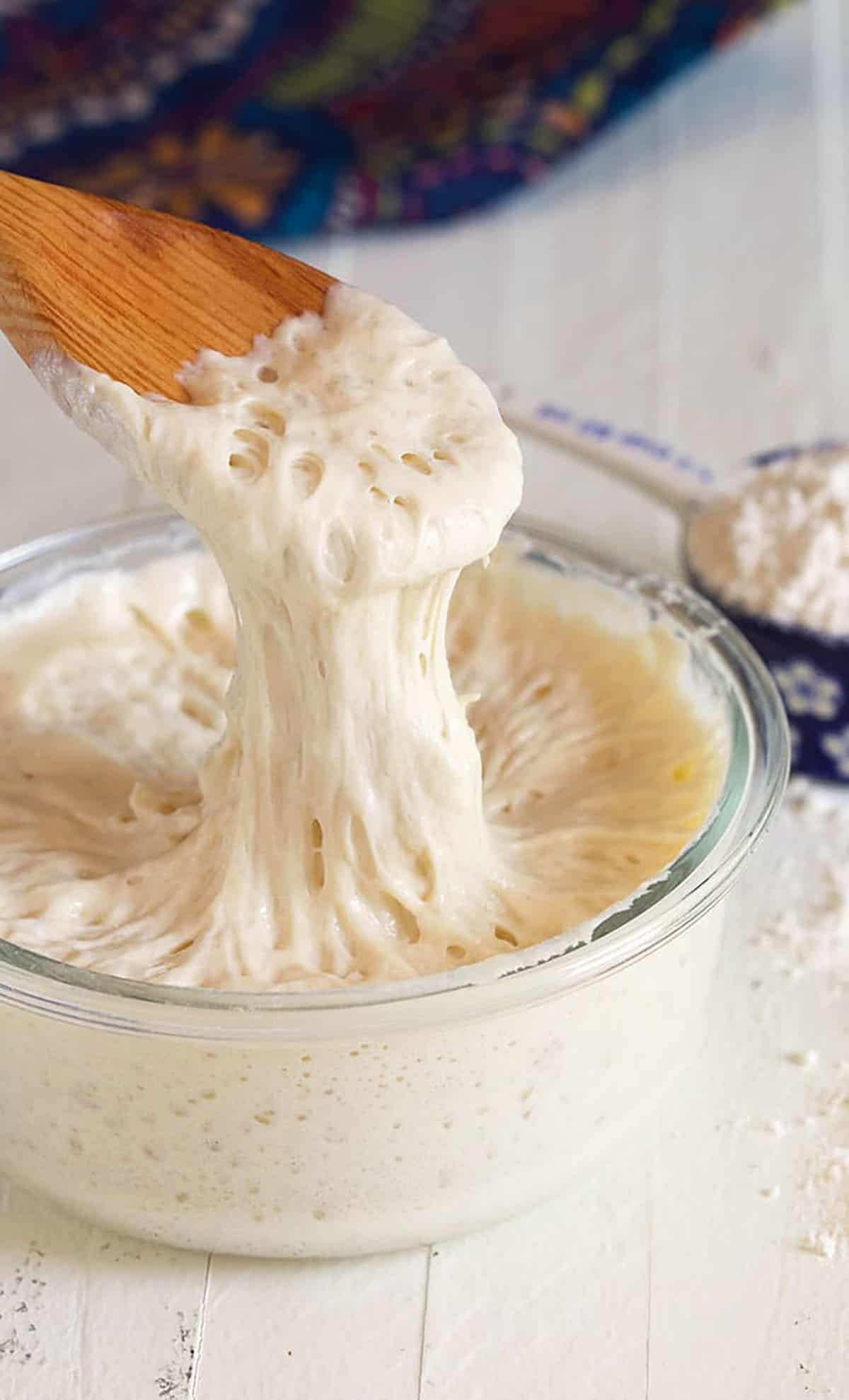
Sourdough Starter
Everyone’s baking bread right now….and buying puppies. I guess the things that seem to take a ton of time and patience are finding their way into homes to keep us busy. My secret is, I’ve always loved baking bread and keep a Sourdough Starter in the fridge for bread emergencies.
My family doesn’t know that this starter is what I throw into things that need a bit of tang and a quick rise when I’m out of yeast. So, a yeast shortage is never a problem because you’re, basically, making your own yeast at home when you make a sourdough starter. And it couldn’t be easier to make.
Making sourdough starter from scratch isn’t fussy or complicated. It all begins with flour and water…..and a little bit of time. That’s it. Easy Peasy!
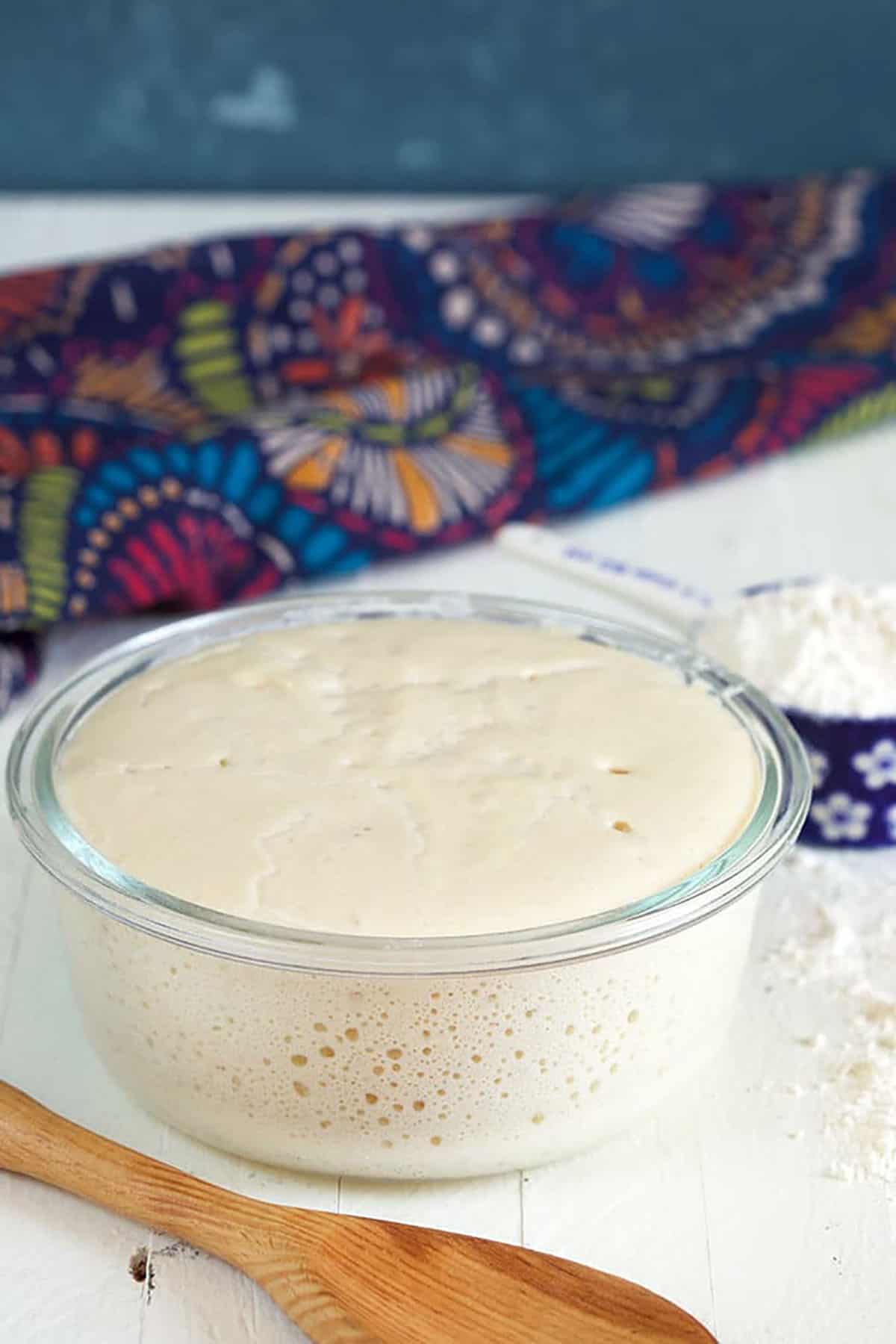
How To Make Sourdough Starter
Although I touched on this a little bit in the last paragraph, making sourdough starter from scratch is super simple to do. The type of flour you use is going to help get things moving more quickly or slowly depending on what you choose.
Wheat flours tend to move things along at a faster pace but since specialty flours are not readily available to everyone, I’ve tested this starter recipe with just about every flour you can imagine.
This Sourdough starter recipe begins with a combination of 1/4 cup all purpose flour and 1/4 cup whole wheat flour.
- Whisk the two together in a bowl until thoroughly combined.
- Add 1/4 cup lukewarm water to the flour and stir until no flour is left. The dough will look thick and paste-like. Don’t worry, this is normal and it will literally transform in just one day or less.
- Cover your jar or bowl and allow to sit in a warm location, ideally over 70˚F is best, covered with a towel or plastic wrap for 24 hours. (Sometimes, I’ll keep my sourdough starter on top of my dryer while it runs to help speed things along.)
- The next day, check to see if your starter has bubbles and has doubled in volume. If it looks the same, cover and allow to sit for another day.
- Once your starter has doubled in volume and has a lot of bubbles forming, it’s time to feed.
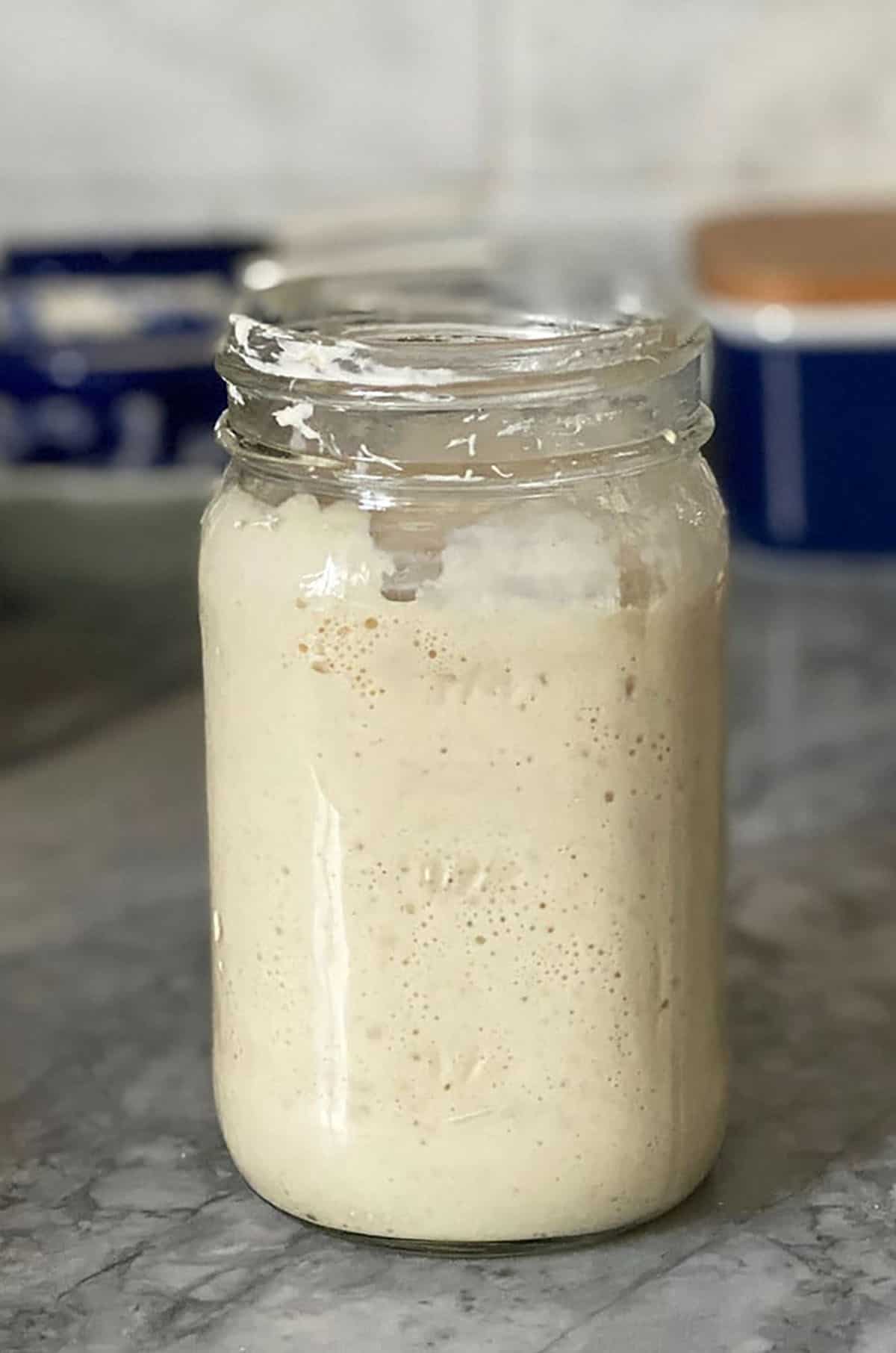
What is Sourdough Starter?
Before you could buy a commercial active dry yeast in a jar or packet at the store, there was wild yeast. Wild yeast can be found just about anywhere like in your flour or in the air. But it must be cultivated into a form that’s suitable for baking and to do that, you create a sourdough starter.
A sourdough starter is simply a combination of water and flour that’s been allowed to hang out for a few days on your counter or other warm place. After a day or so, bubbles will begin to form in the starter and that’s when you know the yeast is becoming active.
To keep things moving along, you feed your starter water and flour for the next several days until the mixture becomes light, bubbly and puffy. Once it reaches that stage, it’s ready to be used.
Wild yeast is finicky when it comes to storage, it likes to be kept at cooler temperatures and in an acidic environment. It’s also is much more leisurely when it comes to rise….in that it takes much longer to proof breads.
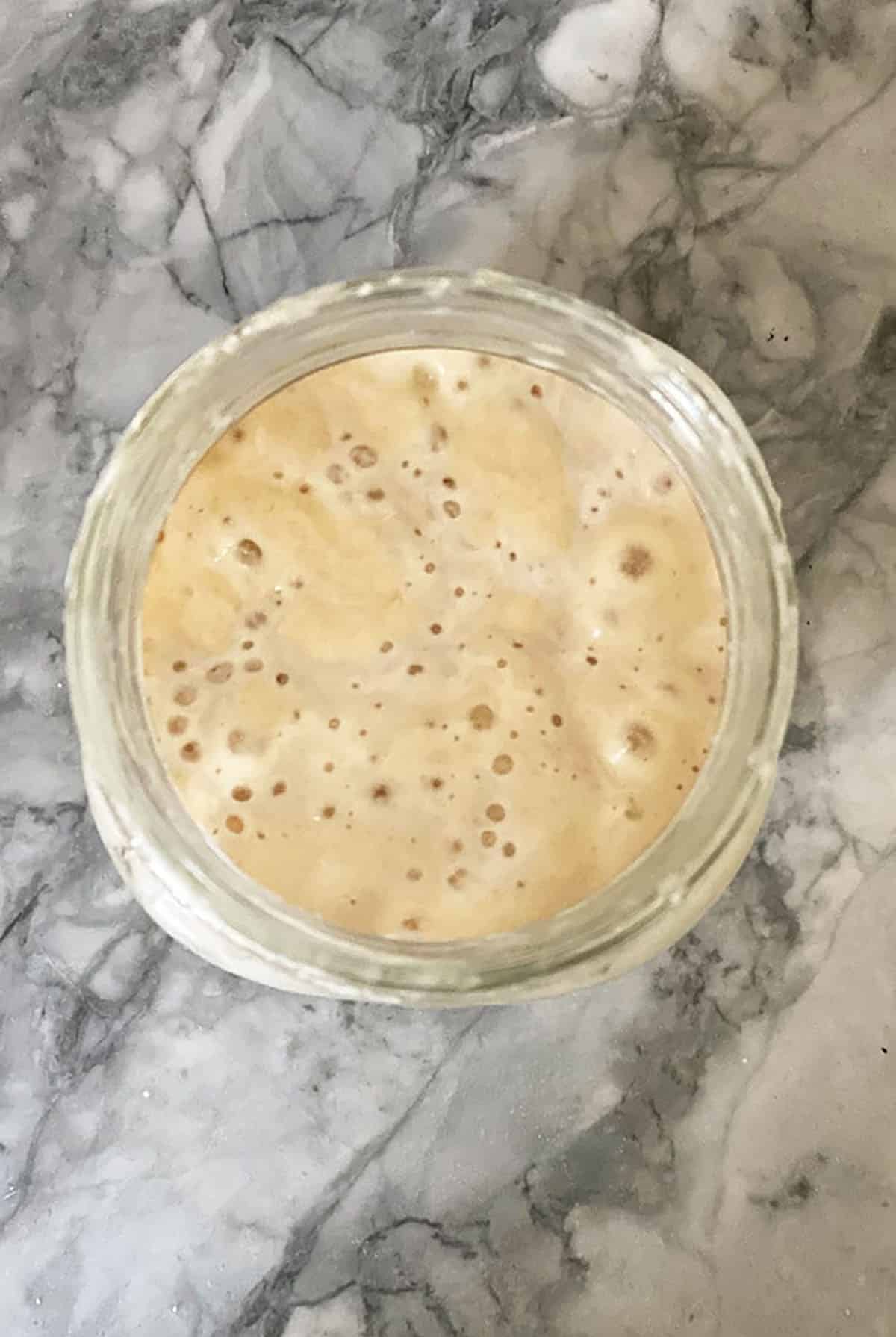
How To Feed Your Starter
Now that the starter has created some movement and developed those happy bubbles, you have to keep it happy by feeding it.
To feed your starter, you will first remove 1/2 of the starter and discard it. Now, when I say discard it, I actually put it in another container and use it for other recipes like pancakes or waffles or muffins, crackers and biscuits. We, also, LOVE these pretzels…they’re crunchy and addicting.
So, you’re not actually throwing it away but you do need to discard half the starter in order to move forward with feeding your starter.
Once you’re removed half the starter, you can now feed it by adding 1/2 cup flour (at this point, I use all-purpose flour only) and 1/4 cup water. Stir the mixture to combine thoroughly and cover with a towel.
Allow the starter to rest another 24 hours.
Repeat this process of feeding your starter each day for 3-5 more days until the starter is super bubbly and billowy and light. At this point, it’s ready to use for a freshly baked loaf of sourdough bread!
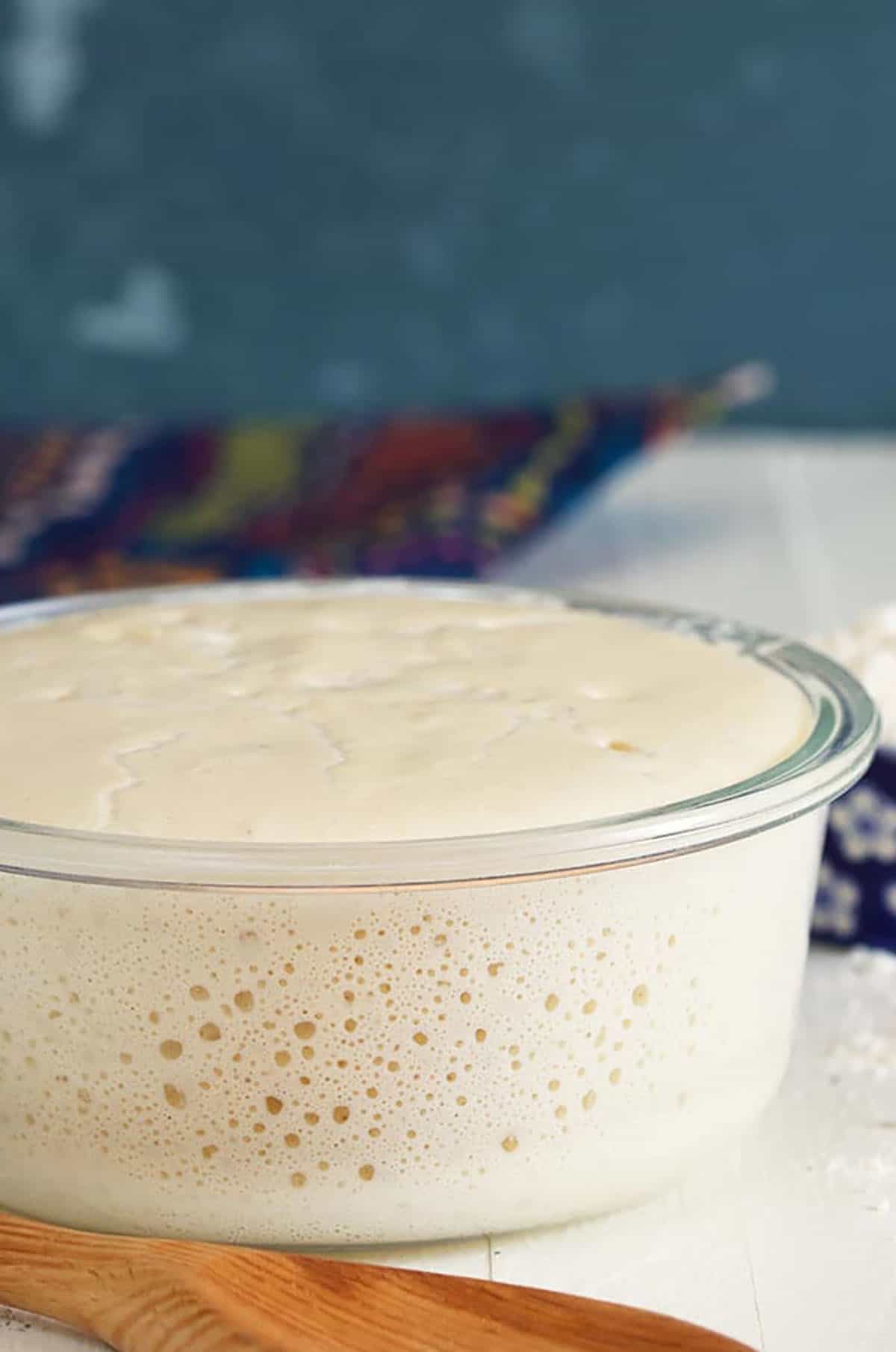
The Best Flour To Use
You can use any flour for your starter that is made from a grain. So, rice flour, wheat flour, rye flours, spelt flour, barley flour, sprouted flour and bread flour will all work well. You can make gluten free starter by using a gluten free flour like rice flour.
I haven’t tested it with most of the listed flours like rice flour so you may need to do a bit of research before going down that path.
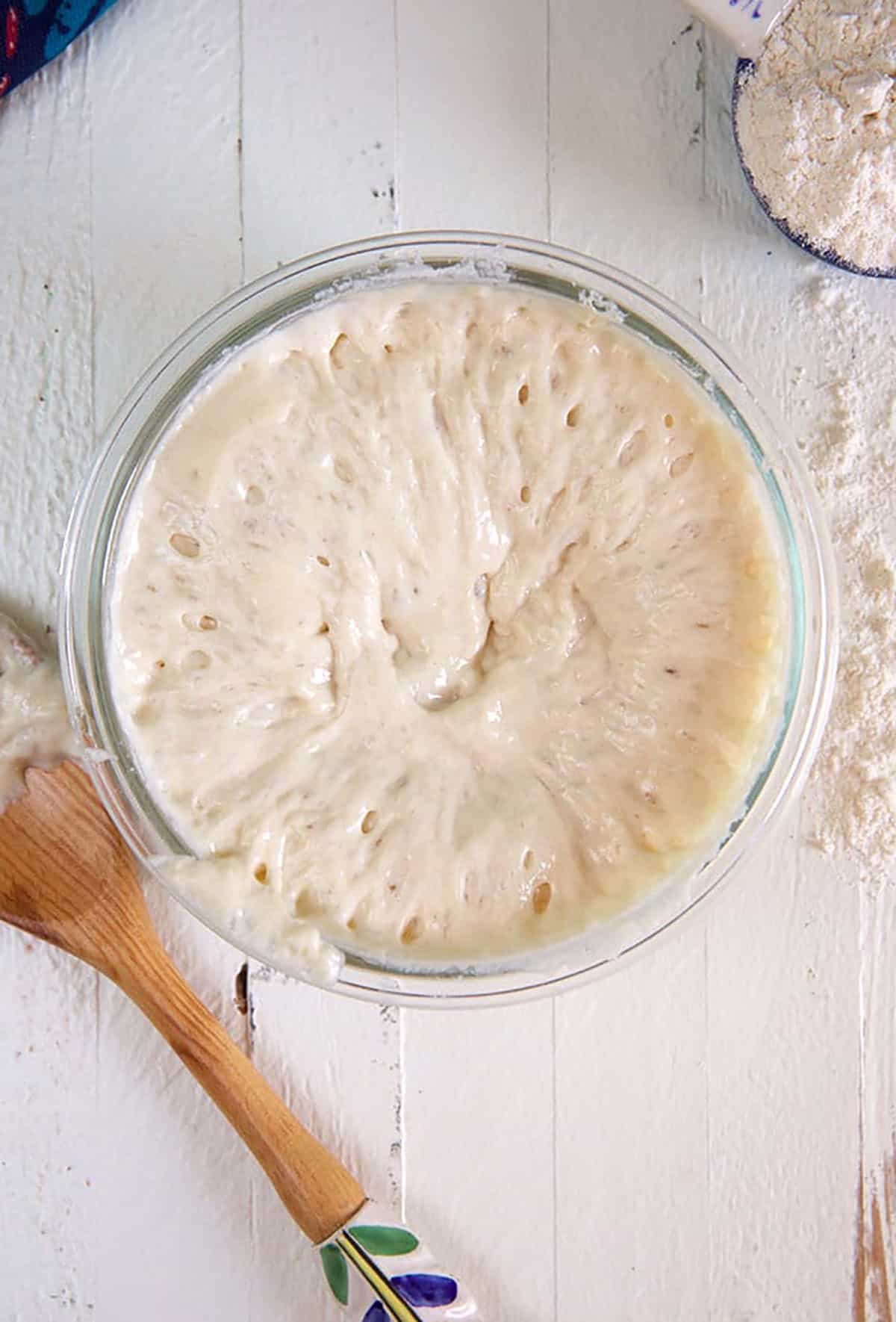
Storage Tips
- You can safely store your starter in the refrigerator in a container.
- Pick a feeding day and stick to it.
- Remove the starter from the refrigerator and allow it to sit at room temperature for a few hours before feeding it. Feed it 1/2 cup flour and 1/4 cup water. Allow to sit overnight until bubbly then return to the refrigerator.
- You can leave your starter in the refrigerator for longer periods of time but you will need to allow it to rest at room temperature for a few days to revive it. Feed as normal and you should be back in business.
- You can successfully FREEZE sourdough starter by adding twice the flour at a regular feeding and then wrapping tightly in plastic wrap. Freeze for up to 3 months. Allow to thaw at room temperature and rest in a container for several days to wake it up. Then, feed as directed.
This easy sourdough starter recipe can be used in so many recipes and I love the easiest ever sourdough bread recipe. If you don’t want to wait for your starter to grow and you have traditional yeast on hand, you may want to try this easy Brioche Bread recipe or our favorite White Bread. Both have been on repeat for the past several weeks.
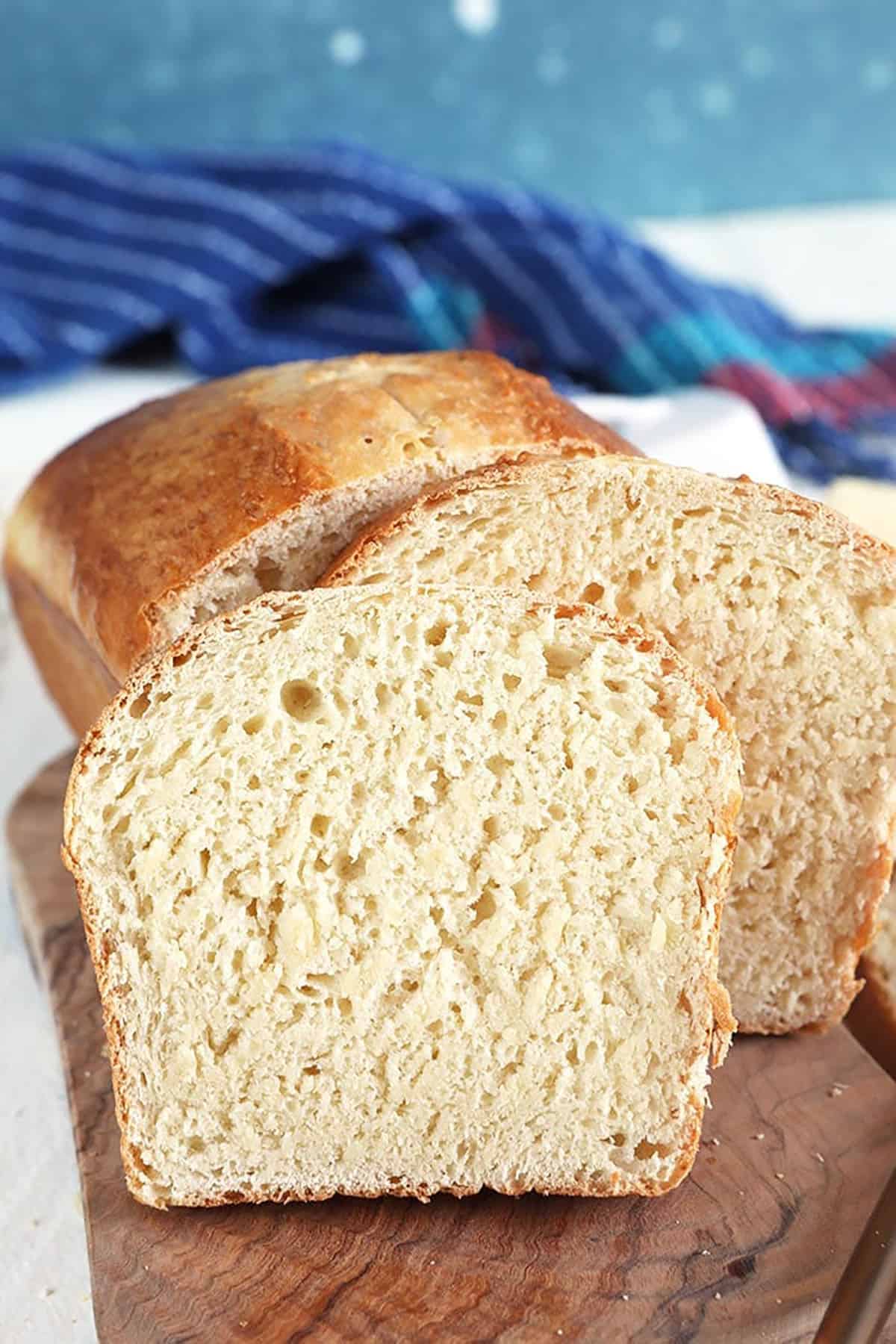
Sourdough Recipes
While you feed your starter, you’ll have a bit of discard to tend with. You can toss it or you can save it in a container in the refrigerator to use in recipes. However, don’t use discard from a new starter. Be sure your sourdough starter is at least 7 days old before reserving the discard for other recipes.
You could also use this starter as a substitute for yeast in these easy Brioche Buns to give them a tangy flavor that’s so not common in a buttery brioche.
DON’T MISS A RECIPE! Be sure to follow us over on Instagram (where I shared the behind the scenes how-to on making this easy starter recipe) and on Facebook!
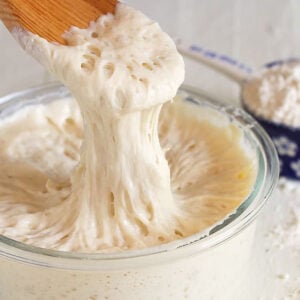
Get the Recipe: Sourdough Starter Recipe
Ingredients
- 1/4 cup Whole Wheat Flour, or other whole grain flour
- 5 lb All Purpose Flour
- 1/4 cup water, room temperature
Equipment
- 1 clean jar
Instructions
Day 1
- In a wide mouth 4 cup jar or bowl, whisk together 1/4 cup wheat flour with 1/4 cup All Purpose flour until thoroughly combined.
- Using a fork, stir in the water until no dry flour is remaining. The mixture will resemble a thick dough or paste that's a little on the dry side.
- Cover loosely with the lid or plastic wrap and leave in a warm spot in the kitchen (ideally over 70˚F) for 24-48 hours.
Day 2
- Check your starter for activity, sometimes you'll see tiny bubbles and maybe a little activity. Sometimes you won't. If you see nothing, give it a stir…cover loosely and allow it to sit for another 24 hours.
Day 3
- By this time, you should see lots of bubbles and expansion of your starter. To gauge how much your starter is growing in volume, you can place a rubber band around the jar at the top of your starter to see if it doubles in size. I prefer to just eyeball it. Discard half your starter (saving the discard in a separate container for later.)
- Add 1/2 cup all-purpose flour and 1/4 cup lukewarm water to the remaining starter. Stir to combine until no dry flour is visible. Cover loosely and allow to rest at room temperature in a warm location for 24 hours.
Day 4-7
- At this point, you should see your starter doubling in volume with lots of bubbles each day. Continue feeding your starter each day by discarding half the starter then feeding with 1/2 cup flour and 1/4 cup water.
- Cover loosely and allow to rest at room temperature in a warm location for 24 hours. By day 7, your starter should be ready to use in your favorite recipe.
- To test if your starter is ready to use, feed the starter and time how long it takes to double in size. When your starter doubles in less than 4 hours, it's ready. Alternatively, you can do the float test. Simply fill a glass with water and place a bit of starter in the water. If it floats, it's ready to use. (I'm not a fan of the float test….just saying.)

105 Comments on “How to Make Sourdough Starter”
When do you add the yeast?
There’s no yeast in Sourdough Starter. The fermentation process is the yeast.
Why do you have to use all purpose flour in a starter if you want to make 100% whole grain bread?
If you want whole grain bread then use all whole grain flour.
Can you start another jar with the discarded?
Yes, you can definitely start another jar of starter. I, sometimes, gift it to friends and family.
Do I need to feed the discarded starter or can I let it just sit in the refrigerator?
Thanks!
– Malcolm
If you want it to rest and not double, you can store it in the refrigerator and not feed it. It will, basically, go to sleep until you take it out and allow it to come to room temperature. At that time, you would need to feed and discard like you would normally.
Hi, I’m on day 4 and it did not rise at all but it is still bubbly and has some water setting at the top. I think it got too cold last night so I have it sitting in the oven turned off but with the light on. Should I still feed as normal today or wait till it has risen more?
Hi Tess, Sometimes when it gets a little chilly it just kind of hunkers down and doesn’t grow. That’s when I’ll set it in a sunny place in my kitchen or on the countertop above the dishwasher while it’s running or even on top of the dryer. I would give it another day before you feed it. If it doesn’t budge, then just move forward feeding it and that should wake it up a bit.
Hello!
I have not discarded at all! Can i still use my starter?! It is bubbling active and smells sour? It has been two weeks since i started it…..i just remembered i haven’t discarded at all this time around!
Thank you!
Yes, I’m so sorry you’re comment was in my spam folder but you don’t always have to discard…it’s just to keep it alive and under control.
Out of curiousity, do you only store the sour dough starter in the fridge AFTER seven days? Or?
So far my sour dough starter is doing good, on day 3 and it had doubled in size. Thanks for the amazing recipe!
I only store it in the refrigerator when I want it to stop growing. It makes it dormant for a bit but once you warm it to room temperature it will start to grow again. So, if you need a break, pop it in the refrigerator until your ready to use it again.
Is it normal to have mold on the sides of the bowl during these 7 days. I changed bowls today day 6.
Hmmm, I never had mold form on the sides of the bowl but changing bowls would be a good idea for sure.
My starter smells poignant is this normal? It doesn’t smell bad just “sour”
It should definitely smell sour.
Can I use 00 flour?
I haven’t tried it with 00 flour but I think it would work well.
At day 10 my starter is like an extra thick pancake batter but with bubbles. It doubles in size in 5 or 6 hours but the next day falls back considerably. Should I continue on 24 hour feeding basis or try making bread now even though the starter looks nothing like yours, no stretch or elasticity. Also little bit sticky. Thanks.
It should be stick, it if is doubling in size you can definitely use it for bread or discard half and feed.
How many loaves will this make??
Well, this is for just a starter that is intended to be kept for all your sourdough baking needs. But if you were to just use the first batch of starter after the 7 day mark you could easily have enough for two loaves.
Once you’ve separated the starter what are some things you can do with the “discard”? Can you keep feeding it too to have multiple jars of starter?
You can keep feeding it, you can use it for some of the sourdough recipes on my site (the crackers are a big hit) or share it with your friends!
In your discussion, you speak of using 1/4 cup all purpose flour. But un the recipe, you call for 5 lbs. of all purpose flour. This looks like an error.
It’s not an error but it’s the amount you’ll need to have on hand to feed your starter. If I only say 1/4 cup of flour then you won’t have extra to feed it each day.
Question- I’ve heard that depending on different regions, the sourdough will take on slightly different tastes…such as San Francisco, because of the salt in the air.
If I boil salt water on the stove a couple of times during the process, could it take on the San Francisco sourdough taste?
Hi Diane, I can’t answer the question about boiling water to change the flavor. But it is true that sourdough will take on a different flavor depending on where it’s being grown.
Do you have to do anything different at high altitude?
Hi Gail! That’s a great question and I’m happy to tell you that your sourdough starter does not need any altering at a higher altitude. That will be a concern when you’re ready to bake. Just let me know if you have further questions. Thank you!